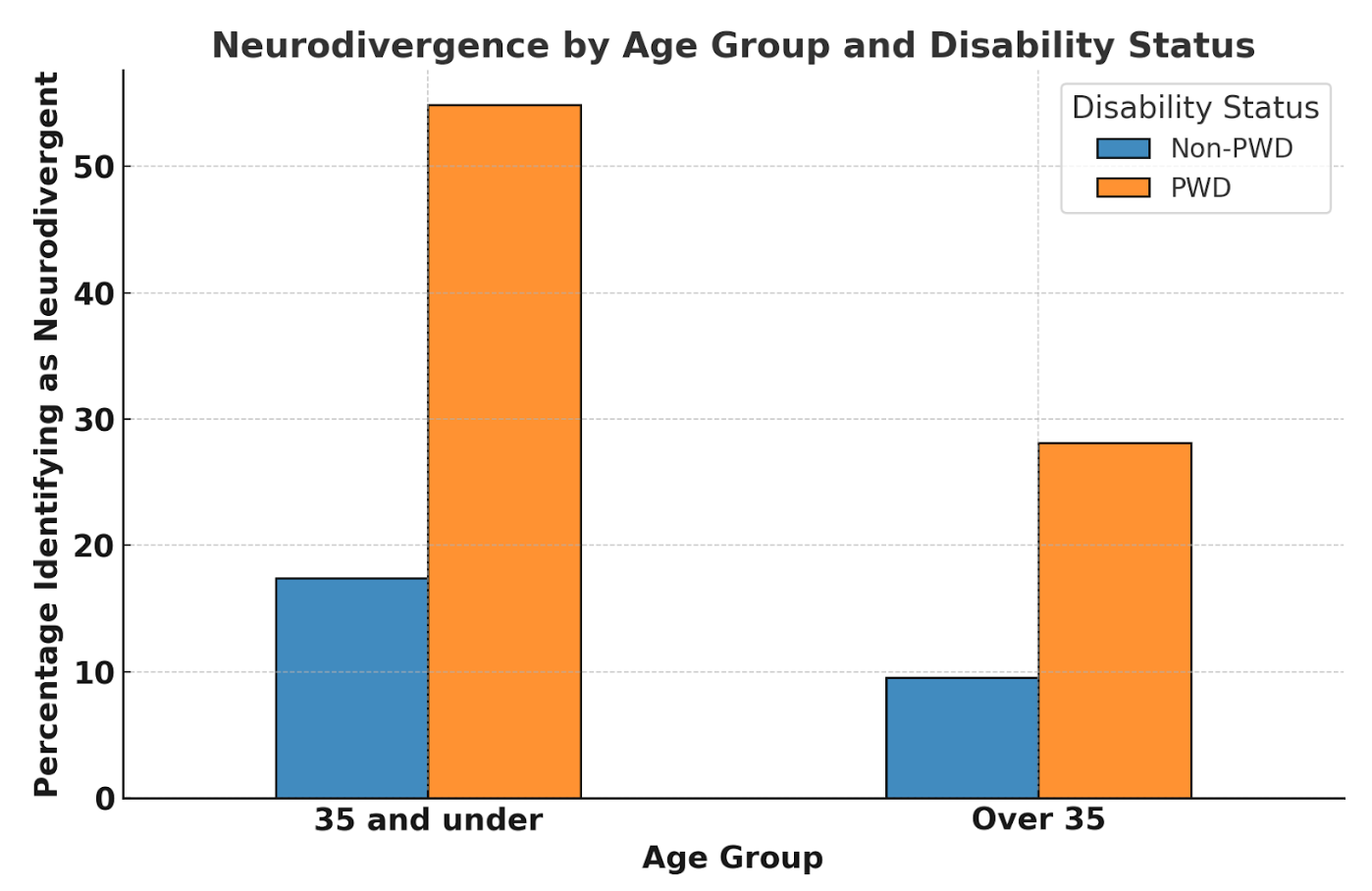A current focus within many HR and accessibility offices is neurodiversity – a nonmedical term for the idea that people experience and interact with the world around them in many different ways.3 Managers are noting, correctly, that those fitting this category are making up an increased percentage of the workforce, with some estimates reach 15-20% for those who struggle with language-based learning challenges and/or disabilities.4 This presents significant operational challenges to employers, especially during training, onboarding, and skills development. It also has the potential to cause breakdowns in manager/employee communications.
One area in which organizations are struggling is understanding how neurodiversity intersects with other employee demographic segments. As part of its 2025 quarterly research program, The Return on Disability Group (RoDG) surveyed 1720 Canadians, 700 of whom self-identified as having a disability.5 All participants were currently part of the Canadian labor force. Participants were asked about engagement at work, as well as about disability and self-identification with neurodivergence.
Survey results revealed several patterns. Among the most prevalent is that those who self-identify as having a disability are almost 4x more likely to self-identify as neurodivergent. For those that self-identify as having a cognitive disability and/or mental health concerns, the likelihood of self-identifying as neurodivergence is nearly 6x higher than the non-disabled population (see Figure 1).

These findings strongly suggest that talent strategies pertaining to neurodivergence should be integrated into a wider disability strategy. Even those with physical or sensory disabilities are far more likely to identify as neurodivergent than those without disabilities. Additional age-related findings underscore the necessity of such an approach.
The most striking finding surrounding neurodiversity self-identification pertains to age. Those under 35 are nearly twice as likely to self-identify as neurodivergent. This relationship holds true within and outside disability. 17% of those without disabilities under the age of 35 self-identify as neurodivergent. For under 35 PWD, this number rises to a whopping 55% (see Figure 2).

It should be noted that these figures refer to self-identification, not a functional assessment of learning or communication styles/challenges. Still, this level of identification is important to note for ensuring employers maximize the engagement potential of its workforce.
Employees are more frequently identifying as neurodivergent. This trend is especially noticeable both for those with disabilities and for younger workers. Maximizing engagement of these groups means acknowledging the ways in which they view themselves, which increasingly is tied to different ways of communicating and consuming information. Failure to engage employees on their own terms is more likely to reduce engagement, and ultimately, increase turnover. There is opportunity to integrate neurodiversity programs into generalized HR practice to maximize impact on a workforce that will increasingly identify as such.
This document respects various best practices regarding accessible documents, including our choice of typeface, type size, hue contrasts, margins, document structure, and heading styles.
Ph.D., Managing Director of Research and Design at RoDG is an experienced researcher in the academic sector, who has conducted qualitative research with under-represented communities in multiple countries and in multiple languages. Drawing on years of research and advisory work with leading organizations—including major banks, telecommunications companies, and global consumer brands, Mark delivers actionable insights that help businesses unlock the full potential of the disability market.
RichDonovanCEO/Founder at RoDG is a globally recognized subject matter expert on the convergence of disability, user delight, and corporate profitability. He has spent more than 17 years defining and unlocking the economic value of the disability market. He is a person with a disability.
RoDG’s public research empowers executives and policymakers to integrate disability into core business strategy, driving both customer and employee experience. For more research and practical tools, visit www.rod-group.com.
1 This document complies with all applicable EN 301 549, WCAG 2.0 and 2.1 Level A and Level AA guidelines for accessible digital documents. For alternative formats, contact Return on Disability at mark@rod-group.com. We always strive for plain language; however, we often cannot write about topics such as conformance and compliance using simpler language without losing critical meaning.
2 © The Return on Disability Group. All rights reserved. The information contained herein is not represented or warranted to be accurate, correct, complete or timely. This report is for information purposes only and should not be considered a solicitation to buy or sell any security.
3 Baumer, Nicole and Julia Frueh. 2021. “What is Neurodiversity?” Mind & Mood. Harvard Health Publishing. Available at https://www.health.harvard.edu/blog/what-is-neurodiversity-202111232645
4 International Dyslexia Association. Available at https://dyslexiaida.org/frequently-asked-questions-2/
5 Return on Disability quarterly survey, first quarter 2025. Note ratio of disability to non-disability is inflated for better statistical comparison of the two groups.
SHARE POST:
Grounded in users, Return on Disability delivers deep insights into your experiences. We translate new insights into design adjustments that delight from disability.

There is often an assumption that the shopping preferences and behaviors of Persons with Disabilities

A significant internal obstacle to internal accessibility – that for employees – is understanding potential

In 2023 Statistics Canada released results from the 2022 Canadian Survey on Disability (CSD).3 This
Lorem ipsum dolor sit amet till, consectetur adipicing elit till.